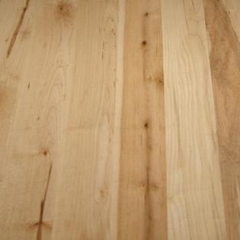Unfinished Solid Flooring
 Considered the highest-quality flooring, unfinished solid hardwood is the oldest form of wood flooring and comes in longer plank sizes than prefinished and engineered types. Solid hardwood flooring is used with wood subfloors or is created with a floor joist system. Unfinished solid flooring is nailed or stapled into place and sanded, and then a finish is added.
Considered the highest-quality flooring, unfinished solid hardwood is the oldest form of wood flooring and comes in longer plank sizes than prefinished and engineered types. Solid hardwood flooring is used with wood subfloors or is created with a floor joist system. Unfinished solid flooring is nailed or stapled into place and sanded, and then a finish is added.
As with any type of unfinished flooring, unfinished solid hardwood offers several design possibilities with stains. Rather than going off color samples (the typical procedure for prefinished flooring), you can test different stains in your home and find which one works best with the space. Once you have found the best stain, all test spots can be sanded down. Solid flooring can be sanded a nearly-unlimited amount of times.
Prefinished and unfinished solid hardwoods meet different flooring needs, but when it comes to purchasing a product, grading is more consistent for the latter. Prefinished grades are often assigned by each manufacturer, and grading for unfinished hardwoods is based on National Wood Flooring Association (NWFA) guidelines. If you choose a domestic species of unfinished flooring for your home, the grading options include:
• Clear – has an even appearance primarily composed of heartwood.
• Select – almost as uniform as Clear but with a few natural marks, like mineral streaks.
• #1 Common – offers more color variety and displays character marks, such as small knots and color variation.
• #2 Common – Greater color variation and more distinct character marks.
• #3 Common – Value flooring with larger and more ubiquitous knots, streaks, and color variation.
Depending upon the amount of time you have for installing a floor, unfinished solid hardwood has a couple of disadvantages. Installation takes longer and involves sanding and finishing, which may take weeks in some cases. During installation, the area for the hardwood floor needs to be clean and untouched.
